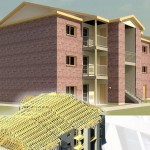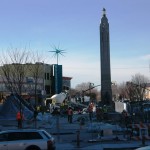 Have you heard of the Hyatt Regency walkway collapse? In 1981, a fourth-floor elevated walkway stretched over the hotel lounge in Kansas City, Missouri. On a busy Friday evening during a dance, the walkway gave way, crashing onto the crowded lobby below. Tragically, the collapse killed 114 people and injured another 200.
Have you heard of the Hyatt Regency walkway collapse? In 1981, a fourth-floor elevated walkway stretched over the hotel lounge in Kansas City, Missouri. On a busy Friday evening during a dance, the walkway gave way, crashing onto the crowded lobby below. Tragically, the collapse killed 114 people and injured another 200.
The root cause of this disaster was the weight distribution stress on the walkway. The original design was altered during construction, increasing pressure and stress on the walkway structure. Unfortunately, this change did not meet minimum safety requirements, but the oversight was not caught during inspections or afterward until it was too late.
Structural failures like the Hyatt Regency collapse highlight the critical role of structural engineers. These professionals assess the safety of building designs and the quality of construction to ensure buildings meet safety standards. But what happens when construction is over? Over time, even well-constructed buildings can deteriorate. This is why structural assessments are essential for maintaining the safety and functionality of existing structures.
Why are structural assessments needed?
All buildings experience wear and tear due to age, environmental damage, weather events, or seismic activity. As structures age, their materials weaken, potentially compromising their integrity. Regular structural assessments evaluate these changes and ensure that buildings remain safe for occupants.
Structural assessments are necessary for addressing visible signs of deterioration, like cracks or sagging, and identifying hidden vulnerabilities before they lead to catastrophic failures. These evaluations help property owners and managers proactively address issues, extending the life of their structures and ensuring compliance with evolving safety codes.
What Is a structural assessment?
A structural assessment, also known as a structural evaluation, is a detailed review of a building’s condition conducted by licensed structural engineers. This process involves a combination of site visits, inspections, and specialized tests to evaluate a structure’s safety and performance.
Typical activities during a structural assessment include:
- Visual inspections: Engineers examine the building for signs of damage, such as cracks, corrosion, or deformation.
- Concrete testing: Core sampling and other methods are used to measure the durability of concrete components.
- Foundation analysis: Engineers look for signs of settlement or instability in the foundation.
- Material studies: They evaluate the quality of construction materials to determine their remaining lifespan.
- Structural assessments are often required annually or after significant events like earthquakes, hurricanes, or reported structural incidents.
Benefits of a structural assessment
- Preventing failures: Structural issues like cracking, swelling, or uneven foundations often start small but can lead to significant problems if left unaddressed. A thorough assessment uncovers these hidden vulnerabilities and recommends repairs for the issue.
- Enhancing safety: Assessments ensure that buildings, bridges, or infrastructure meet safety standards, preventing accidents and protecting lives. Many older buildings no longer meet current safety or building codes and structural assessments are critical for ensuring these structures are still safe for usage and comply with regulatory requirements.
- Informed decision making: An assessment can help building owners or property managers to plan renovations or maintenance. Existing buildings that are up for sale can also be assessed to find potential liabilities or determine the value of the property.
Project Spotlight: Good Trump Court in Deer Valley, Utah
Our team regularly conducts structural assessments, and we highlighted a recent evaluation we did in our spring 2024 newsletter. Our structural engineering team was hired by the Homeowners Association of Queen Esther – Good Trump Court to assess two fourplexes and a duplex. The HOA wanted a report on the existing conditions of the buildings before undertaking significant design upgrades.
During the assessment process, our team uncovered several signs of damage issues, including:
- Signs of rotting siding, cracked grout and stone degradation which likely indicated subsurface issues that would require further analysis.
- Leaks in the building roof which were caused by the roof’s complex design as it wore down over time.
We prepared our report using intensive point cloud scans, which allowed us to capture the state of the building accurately. We also studied the type of construction materials used to determine their remaining longevity.
As part of our assessment, we included recommendations for the HOA on preventative and aesthetic updates. Our recommendations included a hybrid roofing solution using standing seam metal and EPDM (Ethylene Propylene Diene Monomer) to address the roof leaks. We also recommended exterior updates to enhance the look of the building and replace damaged siding and building materials. Our assessment report helped the HOA prepare a comprehensive maintenance plan for repairs that will take place in 2025.
Schedule a proactive structural assessment
The tragic collapse of the Hyatt Regency walkway is a stark reminder of the importance of structural integrity and the role of engineers in safeguarding our built environment. Structural assessments are essential for preventing disasters, enhancing safety, and ensuring that buildings remain functional and compliant with safety standards.
Whether you own a commercial property, manage a homeowners association, or oversee infrastructure projects, regular structural evaluations are critical to maintaining the health of your structures. From identifying hidden weaknesses to providing tailored solutions for repairs or upgrades, these assessments help property owners make informed decisions that protect both lives and investments.
Don’t wait for signs of trouble to appear. Proactive structural assessments can save lives, reduce costs, and extend the lifespan of your building or infrastructure. If your property needs a professional evaluation, consult with experienced structural engineers today. With their expertise, you can ensure your structure stands the test of time.








